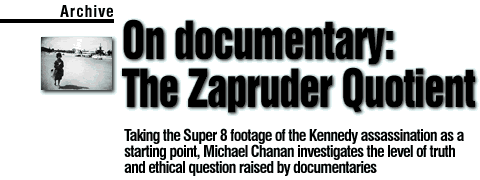
Nothing shows so clearly the growth of scepticism in the twentieth century as our attitude towards documentary. The emergence of the documentary as a recognised cinematic genre in the 1920s inherited a naive trust in the veracity of the image as an authentic representation of the real. Today we no longer see things this way. Documentary has succumbed to a general disbelief in the possibility of objective truth, and the rise of the very inexact concept of relativism. My purpose here is not to defend this relativism, but to suggest that the problem is rather that objectivity is not what it was thought to be.
At the centre of the question of documentary lies the issue of the truth value of the image. The character of the problem is clearly posed in the example of the Zapruder footage, the 22 seconds of Super 8 film of the JFK assassination shot by an amateur cameraman which forms the principal visual material evidence of the event. For many years the footage was suppressed, only to be seen by researchers visiting the government archive where a copy was held; it had been purchased by Life magazine the day after the assassination and published only in the form of still images, minus the frame which shows Kennedy’s head being blown apart. Although bootleg copies were circulating by the end of the 1960s, it was seen publicly for the first time only in 1975, when a U.S. television journalist defied the risk of legal action to show it on network television. Nowadays available on CD-Rom, everyone can confirm for themselves what it shows: Kennedy thrown to the rear by a bullet which according to the Warren Commission, came from behind.
The Zapruder footage is in one description “a home movie taken from the position a Hollywood movie crew would have set up” if they had been staging the event. But it’s shaky and poorly framed, the lens jiggles in response to Mr Zapruder’s reaction to hearing the shot and Kennedy’s head momentarily drops out of the image. However, on close and repeated examination it becomes clear that it shows Kennedy being shot at least twice, and that the second bullet which splits open his head, came from somewhere out in front of him. Researchers who saw it in the 1960s realised immediately that it impugned the Warren Commission. At New York University in the early 1970s, the footage began to acquire the properties of an icon or a fetish. Among filmmakers like Mike Wadleigh and Martin Scorsese there was talk of the Zapruder quotient; according to Wadleigh, “if you had a very high quotient of total amateurism in terms of technique, but the content was superb, what you were filming was absolutely riveting, that was 100% on the Zapruder curve”.
As an emblem of the truth value of the documentary image, this interpretation of the Zapruder footage harks back to the style of direct cinema - what the old school in the BBC used to call wobblyscope - the form of documentary observation first practised systematically in the years preceding the Kennedy assassination by filmmakers in the United States associated with Robert Drew (including Pennebaker, Leacock and the Maysles Brothers); to be distinguished from, though often bracketed with, cinéma vérité, a movement born in France with a film made by a sociologist and an anthropologist who was also an ethnographic filmmaker (Chronique d’un été (1961) by Edgar Morin and Jean Rouch). These films were the first to be made with the new portable cameras equipped with mobile synchronous sound which were also to revolutionise television reportage. The difference between direct and vérité is critical: the former believes that it is possible to get at the truth by reducing as far as possible the filmmaker’s intervention: the latter proposes that the truth will only emerge by foregrounding the filmmaker’s intervention.
The former position, which we can describe as naïve realism, has now of course become theoretically unfashionable, driven out by the arguments of structuralists, semiologists, psychoanalists and postmodernists. The issue is complicated. In brief, the documentary image is in some degree evidentiary, it contains a veridical aspect which is filtered through the particular point of view of the observer filming it, and the skill and craft and artfulness with which the camera is operated – or not, as the case may be. It is one thing to recognise this dose of subjectivity in the image: it doesn’t follow that it therefore is not a true image. For that would be to assume an equation in which the subjective is opposed to the objective, and the objective is identified with truth. In fact the two are not opposed in this way, they are both present at the same time. As the analysis of the Zapruder footage demonstrates.
The philosopher asks: ‘When I see JFK being shot, do I see JFK? Do I see a representation of JFK? Do I see an accurate or inaccurate representation?
The semiologist answers: ...
Michael Chanan’s latest book is: Repeated takes: A short history of recording and its effects on music, Verso, 1995
Full article published in Filmwaves - Issue 4, Spring 1998. Subscribe now!